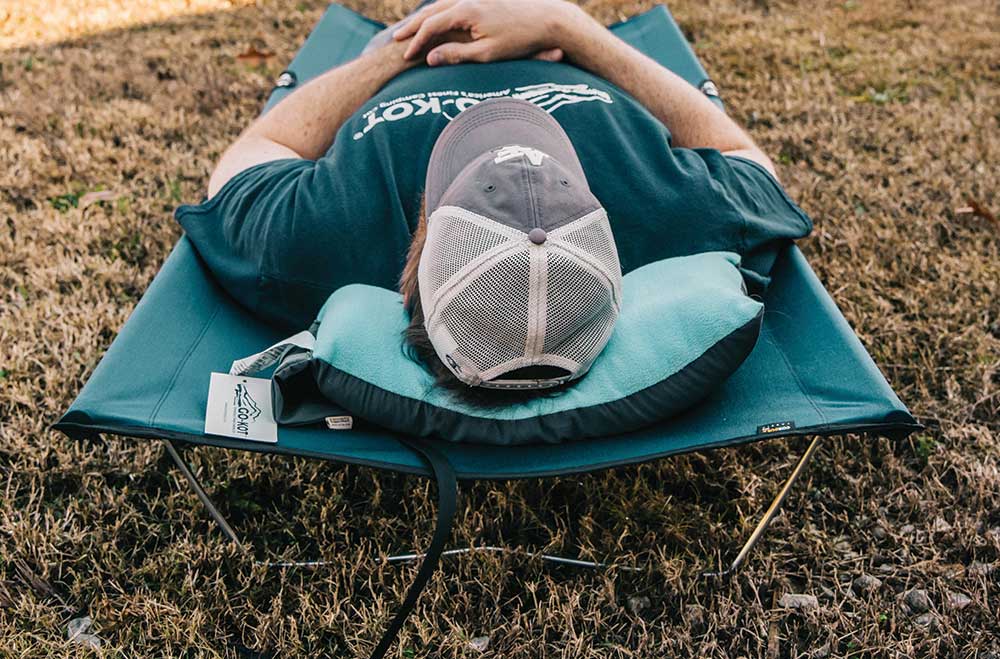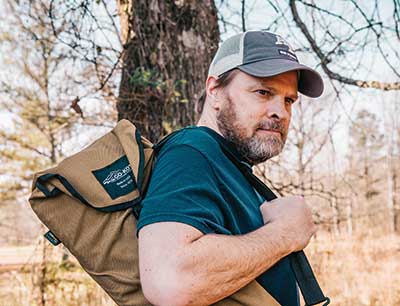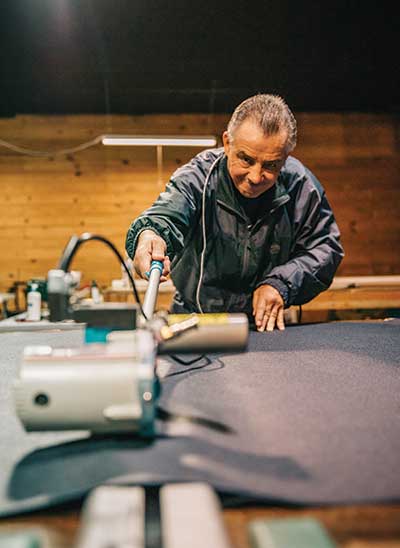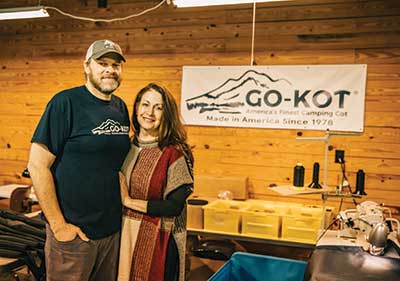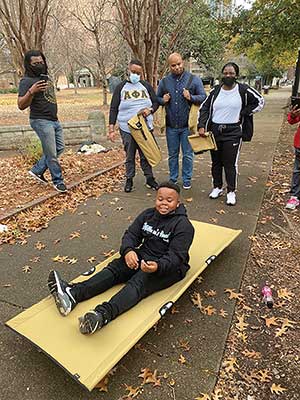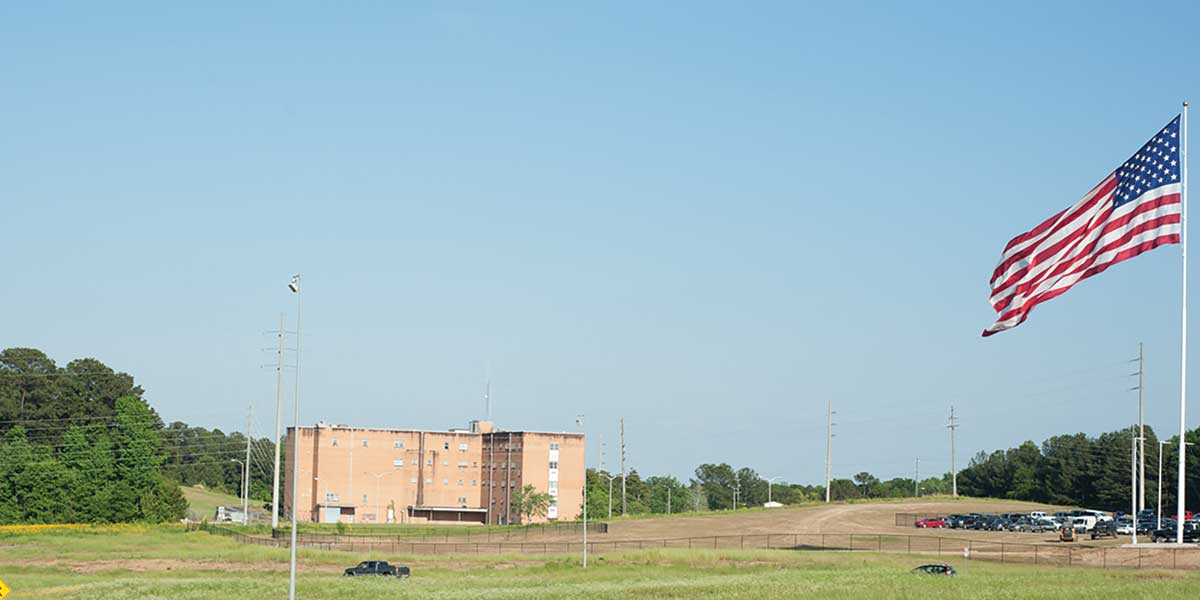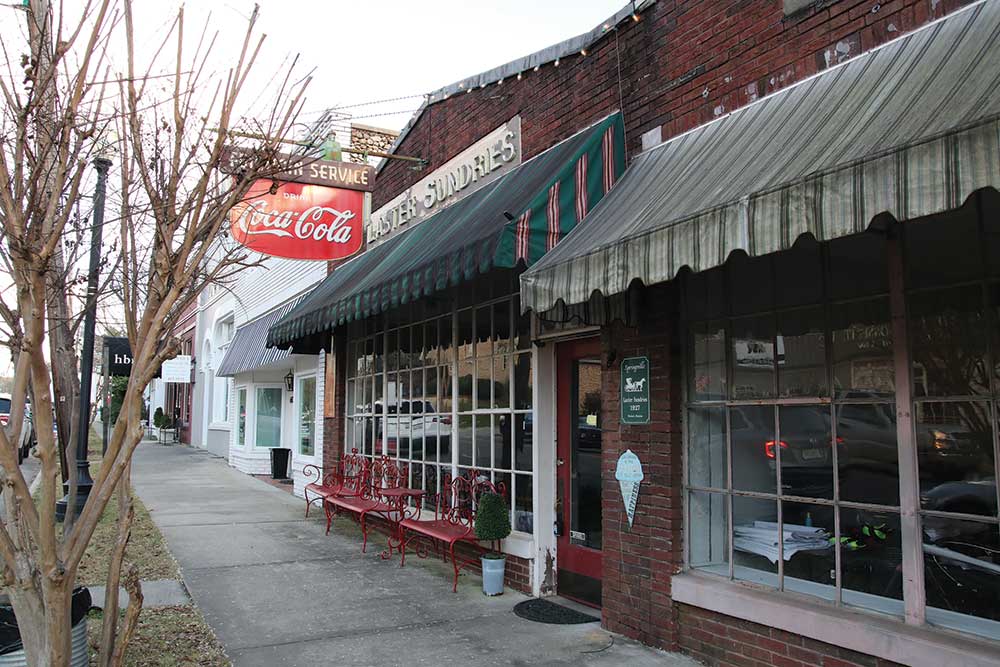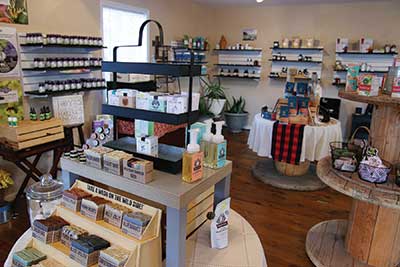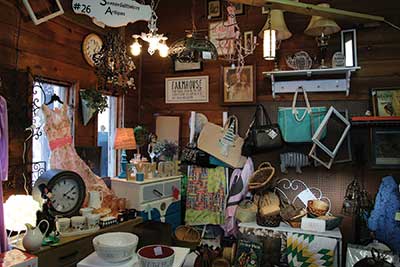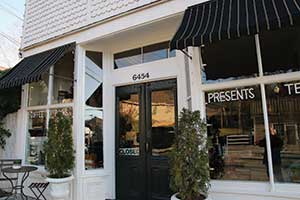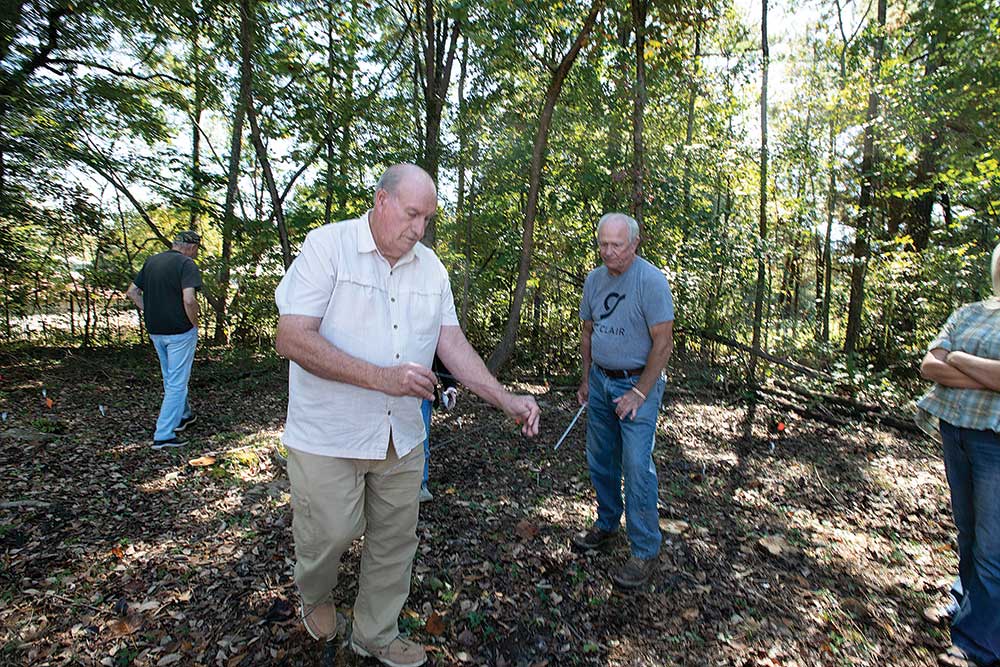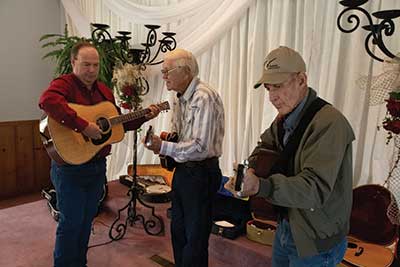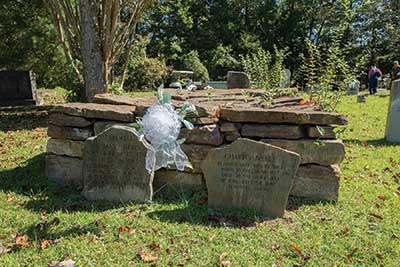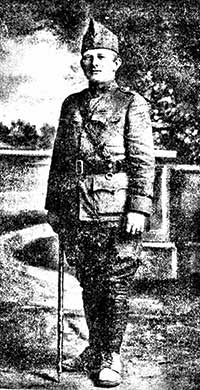Building the bed you can take anywhere
Story by Roxann Edsall
Photos by Mackenzie Free
Two large pallets sit shrink-wrapped and ready to go on the loading dock, just waiting for pickup. Dozens of similar shipments have started their treks from this location already this year.
From the simple facade in Ashville, you’d never know that within its walls is produced a product sought after by the military, by campers, by other countries and by your own neighbors. Owned and managed by two military veterans, the company, GO-KOT®, produces a foldable and packable cot and does it all in St. Clair County.
Mike and Teresa Downing bought the 43-year-old company in 2017 from O’Neal Behel and Pete Smith, who were operating it in Jasper. Several other buyers were interested but wanted to take the operation overseas. Behel and Smith were passionate about selling to someone who was committed to keeping the operation in Alabama. Equally committed to keep the product “Made in America,” the Downings bought the company, operated it in Springville, then moved it to Ashville just over a year ago.
American-made is also the reason they sell to their biggest domestic client, the U.S. military. “We are the only Berry-compliant, low-profile cot on the market,” explains Teresa. The Berry Amendment is a federal requirement that items purchased by the Department of Defense give preference to domestic companies who grow, produce and/or manufacture products in the United States. The cot’s fabric, aluminum, steel and hinges are all domestically made. “Everything about it is made right here in the USA. We’re very proud of that,” says Mike.
The fabric, an extremely durable Cordura brand 1,000 Denier, comes in 50-yard rolls, each weighing about 65 pounds. The frame is made of aluminum, and legs are steel. Both of those elements are shipped in. “Shout out to the best UPS driver out there, Tina Hopper,” Mike says enthusiastically. “She works hard for us.”
Their facility is capable of shipping out 4,000 cots a year, a modest number by major chain standards, but a challenge for a “boutique” local company. “Our competitors are big companies. They have lots of products. We have one product that we make really well,” Mike adds. “The big companies have massive budgets. And they don’t make it locally.
“The biggest challenge in current times is, predictably, shipping. Lead times for materials they need for production has more than tripled in the past year. “What used to take us 6-8 weeks can now take 6-8 months,” Teresa explains. “That means we have to order it way before we need it. That’s not typically good for a business plan.”
The pandemic has also caused some staffing issues. They have a small staff of mostly family and friends. One of their employees on the sewing line is a working mom who struggles with being able to work amid COVID-related school closings and exposures.
Two days a week the Downings have help with the business, but both work hands-on with their product – Teresa on the sewing line and Mike in the metal shop. On those days, after the fabric is marked and cut, the leg holes are stamped out by a huge hydraulic press. Each of the four sewing stations completes a specific task in finishing the fabric and carrying bag.
Meanwhile, in the metal shop, aluminum tubes are being cut and hinged, and the steel legs are bent into the cot’s signature pattern. As the fabric and frames are finished, they are sent to the packing station to be assembled.
The company’s beginnings can be traced back to Pete Smith’s work with a Boy Scout troop. The boys needed cots, so Smith experimented with a product and began making them. The youths and leaders loved the cots, and subsequently the business took off.
Still, quality remained a foundational tenet for the company. When someone complained that the cot squeaked, founder Smith developed a technique to stop the squeak. It’s a technique that is still followed today. Each of the frames is assembled and rubbed end to end with a bar of soap prior to putting the fabric on. “He was such a perfectionist. He took any little comment he ever got and figured out how to make it better,” says Mike. “We don’t get returns. And we have a great product and a great warranty.”
Campers love the cot to get them up off the ground. It’s warmer and more comfortable. But it doesn’t stop at camping. “People also buy them for use at home,” says Teresa. “When my son was still at home, he’d have six or seven friends over, and we used the cots for extra sleeping.” Mike even says he sleeps on one occasionally to help his back.
Son, Gabriel, may be using the cots more in the future, since he’s a military man himself. A 2018 graduate of Moody High School, the 22-year-old is now a junior at the Air Force Academy in Colorado Springs, Colo.
Gabriel is at least partially responsible for their involvement in the GO-KOT® business. “I owned a small boutique in Springville when Gabriel was in 8th grade. We just didn’t have any time to spend together,” explains Teresa. So, she decided to close the boutique and the couple got into the military supply procurement business, sourcing items for the government. They discovered GO-KOT® products in the process and contacted one of the owners about becoming a distributor for him.
He declined because he didn’t want to create a bigger need than he could fulfill locally. The 80-year-old Smith did, however, offer to sell it to them. They spent several months being mentored by him and learning the business. “I didn’t even know how to operate a sewing machine,” says Teresa. “The extent of my sewing skills was putting back on the occasional button.”
Mike and Teresa are quiet, unassuming people. They met when they were both in the Air Force. After tours in Germany, Georgia, Mississippi, Iowa and Ohio, they retired at Keesler Air Force Base in Mississippi. Now they’re working more than full time and say they are inspired by the opportunities their business success has afforded them in missions. They’ve taken several mission trips to Bulgaria, but their favorite mission is a local one. They produce a specialized cot for a homeless mission in Birmingham called “Ethan’s Heart.”
Teresa explains how she saw the story about Ethan Hill on the news and knew they had to help. “He’s a really good person,” she comments on Ethan. “He was just six years old and met a homeless man, used his own Christmas money that first year to buy things to help him and others.”
The couple invited Ethan to come to their operation and decided to support him in his effort to help the homeless. The specialized cots are printed with the words “Jesus loves me, this I know,” a message they hope will be encouraging to those who have found themselves in difficult times.
“Our thought process is that people who don’t have a place to sleep, (those words are) the last thing they see before they close their eyes,” Teresa adds. Since their meeting, the Downings and GO-KOT® have provided about 25 of these cots for Ethan’s mission each year. Ethan trains the recipients on the 60-second set-up procedure before he gives them to each person.
“They’re super fast to put together,” says Mike, demonstrating as he talks. He opens the bag, pulls out the cot and unfolds it. Then he pops the legs into holes in the frame and flips it over. It’s ready to use in seconds.
The cots come in two sizes and several colors. The standard cot is 74-inches long and sells for $189. The premium cot is 84-inches long and sells for $209. Cot accessories, like end kits (to keep sleeping pads in place) and side bags for cellphones and flashlights are also available.
They recently added a dog bed that is two-thirds the length of the standard cot. Go to campingcot.com for more information or to order. Teresa also invites locals to call (205) 384-4134 if they would like to purchase a cot.
For the local bargain hunter, they sell products with slight imperfections at a 25% discount.
The two pallets on the loading dock are headed to Japan, one of GO-KOT’s biggest markets. “They love things that are made in America,” explains Mike. “The Asian market is extremely big for us, so much so that we have three distributors there.”
Mike adds, “The shipping rates are good here, though, because of being in such an accessible location near Interstate 20.”
The Downings also credit the St. Clair County Economic Development Council with being helpful and accessible. “You can talk to an actual person to get help and answers,” says Mike. “It’s our life and our business. People tell you it’s just business. Don’t take it personally. But for us, as involved as we are, it’s very personal.”
Even as all-consuming as the business is, they see themselves continuing for years to come.
Ethan’s Heart and GO-KOT on a mission together
By Roxann Edsall
Submitted photos
Ethan Hill and his nonprofit Ethan’s Heart-Bags4Blessings handed out special editions of the GO-KOT® to some of Birmingham’s homeless population in December at the city’s Linn Park.
Along with the cots, more than 200 Winter Survival duffel bags were given to those for whom the cold is more than just an inconvenience. These bags included food and non-food items donated to the 501(c)(3) nonprofit group through corporate sponsors, a GoFundMe page and an Amazon Wish List. Non-food items included sleeping bags, washcloths, hand warmers, raincoats and thermal blankets.
At just six years old, Ethan was moved by his concerns for a homeless man he kept seeing under the freeway. “He wanted to know what was going to happen to him when it got cold,” said mom Ebony Hill. He was so deeply concerned that he asked to use his Christmas money that year to purchase supplies for “Mr. Marcus” and other homeless people living under the freeway in Birmingham.
In the five years since its inception, the nonprofit has grown so much that the young philanthropist is frequently asked to speak on behalf of the homeless and holds fundraisers throughout the year to raise money and supplies for the next giveaway event.
Editor’s note: For more information or to donate to this continuing mission, go to ethansheartbham.org.











